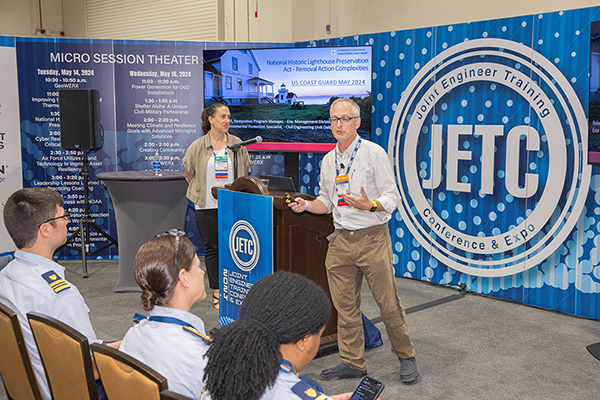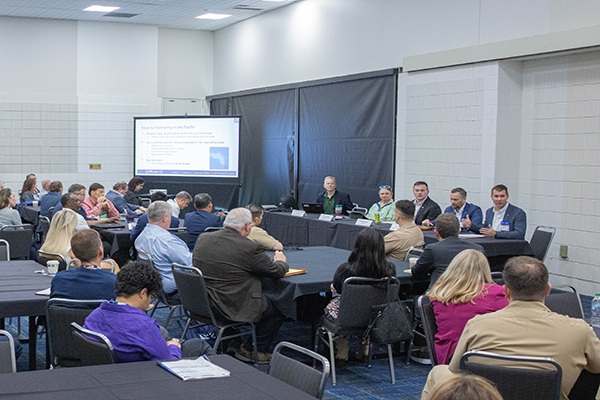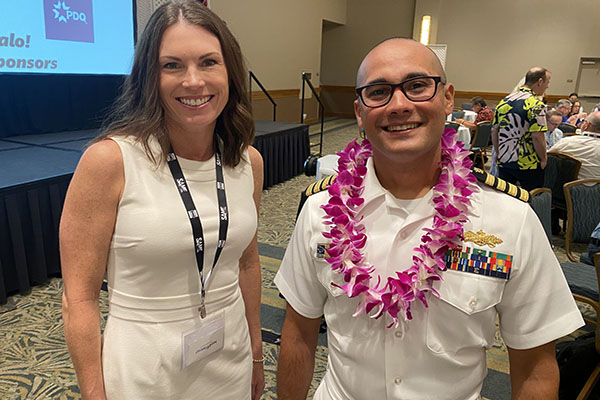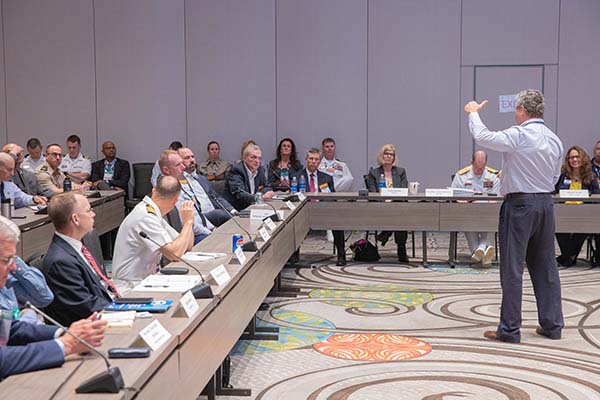As the anchor event to close out the 2023 Capital Week, SAME and the Construction Task Force hosted the inaugural IGE Summit on Wednesday afternoon, March 29. Centered around the topic of “Construction: A Contact Sport,” this opportunity brought together members from both government and industry for a forthright discussion around three pressing issues facing project delivery and the construction sector.
The dialogue resulting during the summit will help set the stage for further explorations during the 2023 JETC, potential avenues for solutions, and, importantly, a wider awareness of both the acute and prolonged risks and concerns facing national security from not having a resilient and agile federal construction base.

CONSEQUENTIAL CONVERSATIONS
The IGE Summit addressed three parallel areas of federal construction and project delivery: a shrinking contractor base, the sharing of risk, and the potential consequences of not making any changes to how we currently operate.
The Shrinking Federal Contractor Base. This breakout session (moderated by Mario Burgos, Burgos Group) discussed the issue of ongoing consolidation and shrinking in the defense industrial base and ways to counteract the trend. To provide some context for the session, it was noted that over the last 10 years the defense industrial base had shrunk by about 40 percent, across both small and large companies. Similarly, the workforce had also contracted, with current figures estimating a 650,000 person shortage. In the discussion, the outstanding issue identified was the high barrier to entry into the federal marketplace. Compared with work in the private sector, the federal sphere has a high barrier of entry and low fiscal returns. This impediment is no singular issue; rather, it is a complex series of challenges comprised of everything from needing to understand and follow an increased number of regulations to complex IT requirements, increased paperwork, bonding requirements, and a lengthy request-for-proposal process.
To begin to get after these entwined issues, the session considered hosting further discussions with all levels of government, members of industry, and groups such as AGC and DBIA. Through a structured forum format, greater understanding of the different sides at play could be gained.
Finally, the session identified the current positioning of risk in the government/contractor relationship as contributing to the downward pressure on the number of contractors active in the federal marketplace. Being able to share risk through a more collaborative model, rather than having the risk flow down from the government, could entice businesses to return to the federal marketplace or enter the space for the first time.
Got Risk? How to Improve Current Project Delivery Methods. This breakout session (moderated by Ben Nichols, Harkins Builders) discussed current and alternative project delivery methods, along with avenues for improvement. To begin, the session identified that while a great variety of delivery methods exist and debate could be had over the merits of each, there was no use in attempting to identify which was “the best.” Instead, participants considered those methods to be more like tools in a toolbox, with some more appropriate to use than others in a specific situation.
Even with this understanding, another insight gathered was that projects where government and industry are able to share the risk rather than having it loaded to one side have a greater chance of increasing trust and fostering a stronger relationship. Setting projects up for a strong foundation early on can go a long way when problems arise down the line. It was identified that delivery methods such as CM At Risk with a GMP model or Early Contractor Involvement have a greater possibility for this foundational trust to be built due to their structure of greater risk sharing.
Another important insight on the adoption of alternative delivery methods was that both owners and contractors require greater training. Since design-build and design-bid-build have been dominant for an extended period, those methods are well understood by both sides. While they might be familiar, and may also be the best fit for certain projects, progress on alternative methods cannot be made if people continue to always reach for the familiar. Getting over that hurdle, getting comfortable with being uncomfortable, and being able to have a frank conversation about how adopting new delivery methods could lead to short-term inefficiencies during the adoption phase is needed.
Can We Afford the Consequences of Not Making Changes? This breakout session (moderated by Rear Adm. John Korka, F.SAME, USN (Ret.), Clark Construction) focused on root causes and what could be done to move the needle on fostering a greater urgency across contractors, an understanding of the critical need for better project delivery, and deeper partnerships between industry and government.
Through discussion, the breakout group zeroed in on potential disconnects between government and industry when it comes to understanding the mission of the owner. A high-level understanding may not always propagate throughout the entire team. A more deliberate effort to educate all personnel is needed. Once that understanding has been digested, the contractor can better link what they are doing and understand how it supports that mission.
Another insight teased out by the breakout session was a greater understanding of what makes industry days successful and how greater trust, understanding, and education on strategic priorities can be gained through such events. To reach the maximum level of success, industry days need to bring together the right people, which means contracting, operations, and owners, as well as design and construction members from industry. Instilling a sense of urgency in contractors can also become stymied by slow project starts and slow communications. Government must be willing to walk the walk and showcase urgency.
GREATER COLLABORATION
Though their approaches to it varied, all three breakout sessions identified that risk and how that risk is shared between government and industry remains a pain point. Seeking out ways to share that risk and transform it into an effective tool to build urgency, build relationships, and ultimately reverse the shrinking trend in the federal contractor base is needed.
The IGE Summit concluded with the Construction Task Force planning to follow up with further discussions at JETC, continuing the lasting commitment by the Society to advance industry-government engagement and support increased collaboration with all those involved in the project lifecycle.
Bringing Industry and Government Together
As the cornerstone of the Society’s founding in 1920, industry-government engagement remains mission-essential for the organization a century later. By leveraging our unique, inclusive platform that brings together members from across the entire infrastructure lifecycle, public and private, SAME is driving solutions for some of the toughest engineering challenges facing the A/E/C industry and our national security. Learn more about SAME’s IGE efforts.
-

National IGE Report: March-April 2025
SAME’s National IGE Report for March-April 2025 covers IGE projects and other ongoing industry-government engagement efforts and updates on their progress. -

National IGE Report: January-February 2025
SAME’s National IGE Report for January-February 2025 covers IGE projects and other ongoing industry-government engagement efforts and updates on their progress. -

National IGE Report: November-December 2024
SAME’s National IGE Report for November-December 2024 covers IGE projects and other ongoing industry-government engagement efforts and updates on their progress. -

National IGE Report: September-October 2024
SAME’s National IGE Report for September-October 2024 covers IGE projects and other ongoing industry-government engagement efforts and updates on their progress. -

National IGE Report: July-August 2024
SAME’s National IGE Report for July-August 2024 covers IGE projects and other ongoing industry-government engagement efforts and updates on their progress.